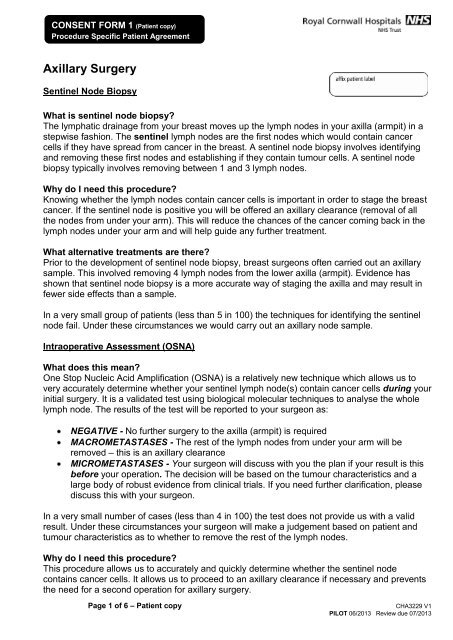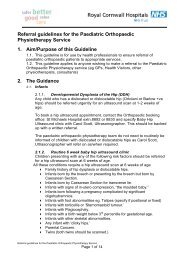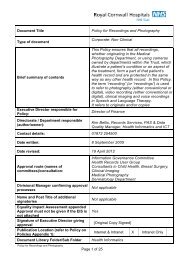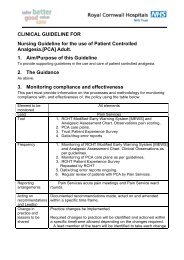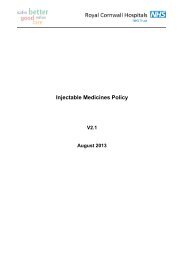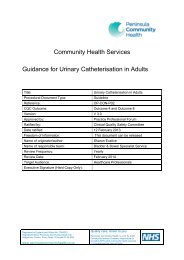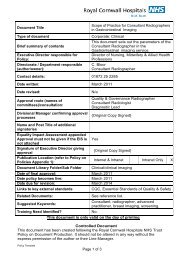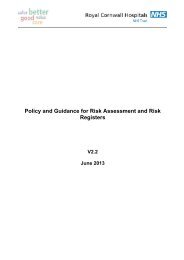Axillary Surgery CHA3229V1
Axillary Surgery CHA3229V1
Axillary Surgery CHA3229V1
Create successful ePaper yourself
Turn your PDF publications into a flip-book with our unique Google optimized e-Paper software.
CONSENT FORM 1 (Patient copy)Procedure Specific Patient Agreement<strong>Axillary</strong> <strong>Surgery</strong>Sentinel Node BiopsyWhat is sentinel node biopsy?The lymphatic drainage from your breast moves up the lymph nodes in your axilla (armpit) in astepwise fashion. The sentinel lymph nodes are the first nodes which would contain cancercells if they have spread from cancer in the breast. A sentinel node biopsy involves identifyingand removing these first nodes and establishing if they contain tumour cells. A sentinel nodebiopsy typically involves removing between 1 and 3 lymph nodes.Why do I need this procedure?Knowing whether the lymph nodes contain cancer cells is important in order to stage the breastcancer. If the sentinel node is positive you will be offered an axillary clearance (removal of allthe nodes from under your arm). This will reduce the chances of the cancer coming back in thelymph nodes under your arm and will help guide any further treatment.What alternative treatments are there?Prior to the development of sentinel node biopsy, breast surgeons often carried out an axillarysample. This involved removing 4 lymph nodes from the lower axilla (armpit). Evidence hasshown that sentinel node biopsy is a more accurate way of staging the axilla and may result infewer side effects than a sample.In a very small group of patients (less than 5 in 100) the techniques for identifying the sentinelnode fail. Under these circumstances we would carry out an axillary node sample.Intraoperative Assessment (OSNA)What does this mean?One Stop Nucleic Acid Amplification (OSNA) is a relatively new technique which allows us tovery accurately determine whether your sentinel lymph node(s) contain cancer cells during yourinitial surgery. It is a validated test using biological molecular techniques to analyse the wholelymph node. The results of the test will be reported to your surgeon as:NEGATIVE - No further surgery to the axilla (armpit) is requiredMACROMETASTASES - The rest of the lymph nodes from under your arm will beremoved – this is an axillary clearanceMICROMETASTASES - Your surgeon will discuss with you the plan if your result is thisbefore your operation. The decision will be based on the tumour characteristics and alarge body of robust evidence from clinical trials. If you need further clarification, pleasediscuss this with your surgeon.In a very small number of cases (less than 4 in 100) the test does not provide us with a validresult. Under these circumstances your surgeon will make a judgement based on patient andtumour characteristics as to whether to remove the rest of the lymph nodes.Why do I need this procedure?This procedure allows us to accurately and quickly determine whether the sentinel nodecontains cancer cells. It allows us to proceed to an axillary clearance if necessary and preventsthe need for a second operation for axillary surgery.Page 1 of 6 – Patient copyCHA3229 V1PILOT 06/2013 Review due 07/2013
CONSENT FORM 1 (Patient copy)Procedure Specific Patient AgreementWhat alternative treatments are there?We are one of a few centres in the United Kingdom who offer this technology.Conventionally, sentinel node biopsy does not require a drain (plastic tube) to the axilla whereasaxillary clearance requires a drain being left in situ for up to one week. Some patients find theidea of waking up with a drain and therefore knowing their sentinel node is positive too difficultto cope with. They would rather find out the result of their sentinel node biopsy in out-patientsand proceed to further axillary surgery after discussion.If you feel this may apply to you please discuss this with your breast care nurse and surgeonand your sentinel node will be analysed in the routine way by the histopathologists.<strong>Axillary</strong> Node ClearanceWhat does this mean?The lymph glands under your arm drain a large area of the lymphatic fluid from your breast andarm, and sometimes a tumour can spread to the lymph glands. <strong>Axillary</strong> node clearance involvesremoving most of these glands. This will reduce the possibility of a recurrence of the tumourunder the arm as well as informing us how many of the glands are affected by the tumour,which helps us plan the next stage of your treatment.What alternative treatments are there?Radiotherapy to the axilla is a possible alternative to axillary clearance. However, this does notprovide any information about the number of lymph nodes containing cancer and the breastteam’s present recommendation in your case is that surgery is the best form of treatment atthis stage.<strong>Axillary</strong> <strong>Surgery</strong>How do I prepare for it?Most patients attend a pre-admission clinic where we will ask for details of your medical historyand carry out any necessary clinical examinations and investigations. Please ask us anyquestions about the procedure, and feel free to discuss any concerns you might have. You willalso have the opportunity to discuss any concerns or queries with a member of the breast carenursing team.Do not eat anything for at least 6 hours before your operation. This is to make sure yourstomach is empty when you have your anaesthetic. Drinks containing fats (e.g. tea or coffeewith milk) and sweets all count as food. You can drink water or a drink without fats in it (e.g.black coffee) until 2 hours before your operation. You may also have small sips of water to taketablets. There is a hospital leaflet about having an anaesthetic. Ask the staff for a copy if youwould like one.You will be given a general anaesthetic during the operation which will keep you asleep. Theanaesthetist will come and see you before your operation to discuss this with you. You will beable to ask them questions about the anaesthetic.A member of the surgical team will also see you on the ward. This is usually the surgeon thatwill perform your operation. Feel free to ask any questions you have about the operation or whatPage 2 of 6 – Patient copyCHA3229 V1PILOT 06/2013 Review due 07/2013
CONSENT FORM 1 (Patient copy)Procedure Specific Patient Agreementwill happen after the surgery. The surgeon will draw an arrow on the side to be operated on andcheck that this consent form has been completed and signed.What does it involve?Your surgeon will decide which technique they are going to use to locate the sentinel node. Thismay involve the injection of a radioactive isotope and / or blue dye around your areola(pigmented area around your nipple), after you are asleep.Your surgeon will make a small incision in your armpit and identify and remove the sentinellymph node(s). They will then be passed to a biomedical scientist (if you are undergoingOSNA), who will analyse them whilst you are asleep.Your surgeon will then proceed to carry out your breast surgery.If your sentinel nodes are positive your surgeon may go on to perform an axillary clearance. Themajority of the lymph nodes from your axilla will be removed. There are important blood vesselsand nerves within your axilla which will be identified and preserved.Your surgeon will leave a soft plastic drainage tube within the space in your axilla to drain awaythe tissue fluid that will be produced as a result of your surgery.What happens afterwards?You will normally spend a night in hospital. The drain will need to stay in until the amountdraining over a 24 hour period is less than 40 - 50 mls. This generally takes between 3 and 5days. You can go home the day after your surgery with the drain in (depending on what surgeryyou have had to your breast) and the district nurses will take over the management and removalof the drain.It may be necessary for you to spend longer in hospital. In that case the nursing team willencourage you to be up and about as much as possible.Before you go home, the nursing staff will check that you are well enough and that theconditions at home are such that you can manage safely.You will be given a leaflet about arm and shoulder exercises depending on the type of axillarysurgery you have had.Are there any risks or complications?As with all procedures there are risks from having this operation:General RisksRisk from the anaesthetic: The risk to a healthy patient of problems arising from an anaestheticis very small. However, each year in the UK a few healthy people will die or suffer serious heart,lung or brain injury following an anaesthetic. For a woman who is otherwise in good health, therisk of a serious complication due to general anaesthesia is less than 1%.Bleeding: This is usually minor and is stopped during the operation. Occasionally, patientsdevelop a collection of blood called a haematoma, which requires a second operation. Foraxillary surgery it is less than 1%.Page 3 of 6 – Patient copyCHA3229 V1PILOT 06/2013 Review due 07/2013
CONSENT FORM 1 (Patient copy)Procedure Specific Patient AgreementInfection: All surgery has a risk of infection. If the wound becomes red, hot or weeps, or you feelunwell you should consult your doctor. Treatment will involve taking antibiotics.DVT/PE: With all surgical procedures there is a risk of developing a clot in the deep veins of theleg, deep vein thrombosis (DVT). In a very small number of patients a bit of this clot breaks offand lodges in the lungs. This is a pulmonary embolus and in very extreme cases can be lifethreatening.Your surgical team will prescribe you compression stockings and/or blood thinningmedication after careful assessment of your individual risk.Risks specific to axillary surgeryReaction to blue dye: This may occur if your surgeon chooses this method of identifying thesentinel lymph node. The skin may become stained with blue around the site of injection andmay take months to fade. In a small number of patients this staining is permanent. A severereaction to the dye (anaphylaxis) has been reported and occurs in less than 1 in 1000 patients.If this occurs you may need to be monitored in an area of high dependency after your surgery,or your surgery may be abandoned.Pain: A degree of pain is likely after any surgery. We aim to manage your pain with painkillers toan acceptable level. In about 30 in 100 patients undergoing axillary surgery some degree ofpain continues beyond the early post-operative period. There is evidence to suggest that if weget on top of your pain in the early post-operative period we can reduce the chance of itbecoming a chronic problem. If the pain or numbness and tingling continues to be troublesomeplease let your surgeon or breast care nurse know and we can give you a medication tomanage the pain.Numbness: The nerves which supply sensation to the back and inner part of your upper armmay be damaged during the procedure. You may experience numbness and discomfort in thearmpit and upper arm. The numbness usually lessens slowly over time and you will becomeused to it.Shoulder stiffness: Your shoulder may become stiff after your operation. Performing theexercises from your information leaflet will help to prevent this.Seroma: This is a collection of fluid under the skin after surgery. It is quite common after axillaryclearance, but is easily treated by drainage through a small needle. Draining the seroma is avery simple procedure that can be done by a member of the Breast Team.Lymphoedema: This is swelling in the tissue below the skin caused by lymph fluid which cannotdrain away. This can occur when the lymph glands are removed (by surgery) or blocked (byradiotherapy). Your hand and arm may swell at any time after surgery. It can affect about 20 to30% of women but only around 5% to a significant degree. There are certain precautions youneed to take to prevent lymphoedema, these will be discussed with you by the BreastCare Team.Winged scapula: This is a rare complication which occurs if one of the nerves in your axilla isstretched or cut during the procedure. If it occurs the shoulder blade becomes prominent andyou may notice less function in your arm and shoulder. It occurs in less than 1 in 100 patientsand may resolve over time with physiotherapy. Occasionally if the nerve is cut it maybe permanent.Page 4 of 6 – Patient copyCHA3229 V1PILOT 06/2013 Review due 07/2013
CONSENT FORM 1 (Patient copy)Procedure Specific Patient Agreement……… <strong>Axillary</strong> surgery+/- Sentinel node biopsy+/- Intraoperative assessment (OSNA)+/- <strong>Axillary</strong> clearanceSTATEMENT OF HEALTH PROFESSIONAL (to be filled in by health professional with appropriateknowledge of proposed procedure, as specified in consent policy)I have explained the procedure to the patient. In particular, I have explained the intended benefitsand summarised the risks, as below:• To determine whether the lymph nodes under your arm contain cancer and remove all the lymphnodes if they contain cancerSignificant, unavoidable or frequently occurring risks:• Bleeding, infection, DVT/PE, reaction to blue dye, pain, numbness, shoulder stiffness, seroma,lymphoedemaUncommon but more serious risks:• Anaphylaxis to blue dye, winged scapulaRare but serious risks:• Anaesthetic risk which includes a very small risk to life or limb from complications such as heartattack and stroke.Any extra procedures which may become necessary during the procedure:• Blood transfusion (required very infrequently)• Other procedure (please specify):I have also discussed what the procedure is likely to involve, the benefits and risks of anyavailable alternative treatments (including no treatment) and any particular concerns of this patient.I have given and discussed the Trust’s approved patient information leaflet for this procedure:<strong>Axillary</strong> surgery CHA3229 which forms the first four pages of this document.I am satisfied that this patient has the capacity to consent to the procedure.This procedure will involve:General and/or regional anaesthesia Local anaesthesia SedationHealth Professional signature:Date:Name (PRINT):Job title:STATEMENT OF INTERPRETER (where appropriate)I have interpreted the information above to the patient to the best of my ability and in a way in which Ibelieve he/she can understand.Interpreter signature: Name (PRINT): Date:Page 5 of 6 – Patient copyCHA3229 V1PILOT 06/2013 Review due 07/2013
CONSENT FORM 1 (Patient copy)Procedure Specific Patient Agreement<strong>Axillary</strong> surgerySTATEMENT OF PATIENTPlease read this form carefully. If your treatment has been planned in advance, you should alreadyhave your own copy of page one which describes the benefits and risks of the proposed treatment.If not, you will be offered a copy now. If you have any further questions, do ask – we are here to helpyou. You have the right to change your mind at any time, including after you have signed this form.I agree to the procedure or course of treatment describe on this form.I understand that you cannot give me a guarantee that a particular person will perform theprocedure. The person will, however, have appropriate experience.I understand that I will have the opportunity to discuss the details of anaesthesia with an anaesthetistbefore the procedure, unless the urgency of my situation prevents this. (This only applies to patientshaving general or regional anaesthesia).I understand that any procedure in addition to those described on this form will only be carried out ifit is necessary to save my life or to prevent serious harm to my health.I understand that tissue samples will only be taken in relation to the procedure explained to me.No samples will be taken for quality control, clinical education or research purposes.I have been told about additional procedures which may become necessary during my treatment.I have listed below any procedures which I do not wish to be carried out without further discussion.I have received a copy of the Consent Form and Patient Information leaflet <strong>Axillary</strong> surgeryCHA3229 which forms part of this document.Patient signature:Name (PRINT):Date:A witness should sign below if this patient is unable to sign but has indicated his or her consent.Young people/children may also like a parent to sign here (see guidance notes).Witness signature: Name (PRINT): Date:CONFIRMATION OF CONSENT (to be completed by health professional when the patient is admittedfor the procedure, if the patient has signed the form in advance).On behalf of the team treating the patient, I have confirmed with the patient that they have no furtherquestions and wish the procedure to go ahead.Health Professional signature:Name (PRINT):Important notes (tick if applicable): See advance decision to refuse treatmentJob title:Date: Patient has withdrawn consent (ask patient tosign/date here)Patient signature: Name (PRINT): DatePage 6 of 6 – Patient copyCHA3229 V1PILOT 06/2013 Review due 07/2013
CONSENT FORM 1 (File copy)Procedure Specific Patient Agreement……… <strong>Axillary</strong> surgery+/- Sentinel node biopsy+/- Intraoperative assessment (OSNA)+/- <strong>Axillary</strong> clearanceSTATEMENT OF HEALTH PROFESSIONAL (to be filled in by health professional with appropriateknowledge of proposed procedure, as specified in consent policy)I have explained the procedure to the patient. In particular, I have explained the intended benefitsand summarised the risks, as below:• To determine whether the lymph nodes under your arm contain cancer and remove all the lymphnodes if they contain cancerSignificant, unavoidable or frequently occurring risks:• Bleeding, infection, DVT/PE, reaction to blue dye, pain, numbness, shoulder stiffness, seroma,lymphoedemaUncommon but more serious risks:• Anaphylaxis to blue dye, winged scapulaRare but serious risks:• Anaesthetic risk which includes a very small risk to life or limb from complications such as heartattack and stroke.Any extra procedures which may become necessary during the procedure:• Blood transfusion (required very infrequently)• Other procedure (please specify):I have also discussed what the procedure is likely to involve, the benefits and risks of anyavailable alternative treatments (including no treatment) and any particular concerns of this patient.I have given and discussed the Trust’s approved patient information leaflet for this procedure:<strong>Axillary</strong> surgery CHA3229 which forms the first four pages of this document.I am satisfied that this patient has the capacity to consent to the procedure.This procedure will involve:General and/or regional anaesthesia Local anaesthesia SedationHealth Professional signature:Date:Name (PRINT):Job title:STATEMENT OF INTERPRETER (where appropriate)I have interpreted the information above to the patient to the best of my ability and in a way in which Ibelieve he/she can understand.Interpreter signature: Name (PRINT): Date:Page 1 of 2 – File copy FILE WITHIN LEGAL SECTION CHA3229 V1PILOT 06/2013 Review due 07/2013
CONSENT FORM 1 (File copy)Procedure Specific Patient Agreement<strong>Axillary</strong> surgerySTATEMENT OF PATIENTPlease read this form carefully. If your treatment has been planned in advance, you should alreadyhave your own copy of page one which describes the benefits and risks of the proposed treatment.If not, you will be offered a copy now. If you have any further questions, do ask – we are here to helpyou. You have the right to change your mind at any time, including after you have signed this form.I agree to the procedure or course of treatment describe on this form.I understand that you cannot give me a guarantee that a particular person will perform theprocedure. The person will, however, have appropriate experience.I understand that I will have the opportunity to discuss the details of anaesthesia with an anaesthetistbefore the procedure, unless the urgency of my situation prevents this. (This only applies to patientshaving general or regional anaesthesia).I understand that any procedure in addition to those described on this form will only be carried out ifit is necessary to save my life or to prevent serious harm to my health.I understand that tissue samples will only be taken in relation to the procedure explained to me.No samples will be taken for quality control, clinical education or research purposes.I have been told about additional procedures which may become necessary during my treatment.I have listed below any procedures which I do not wish to be carried out without further discussion.I have received a copy of the Consent Form and Patient Information leaflet <strong>Axillary</strong> surgeryCHA3229 which forms part of this document.Patient signature:Name (PRINT):Date:A witness should sign below if this patient is unable to sign but has indicated his or her consent.Young people/children may also like a parent to sign here (see guidance notes).Witness signature: Name (PRINT): Date:CONFIRMATION OF CONSENT (to be completed by health professional when the patient is admittedfor the procedure, if the patient has signed the form in advance).On behalf of the team treating the patient, I have confirmed with the patient that they have no furtherquestions and wish the procedure to go ahead.Health Professional signature:Date:Name (PRINT):Important notes (tick if applicable): See advance decision to refuse treatmentJob title: Patient has withdrawn consent (ask patient tosign/date here)Patient signature: Name (PRINT): DatePage 2 of 2 – File copy FILE WITHIN LEGAL SECTION CHA3229 V1PILOT 06/2013 Review due 07/2013


